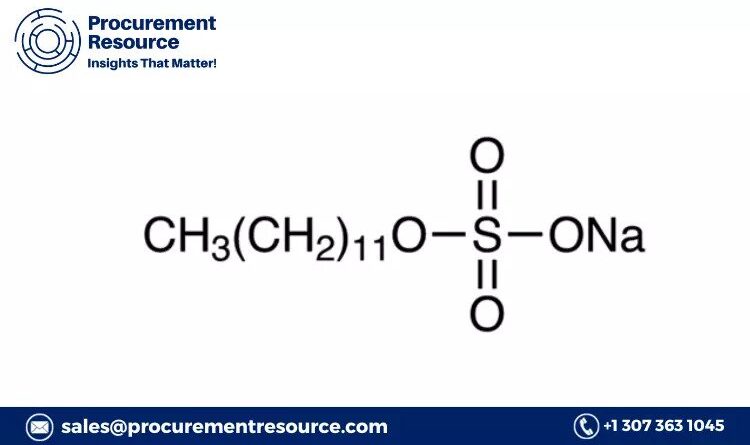Sodium Dodecyl Sulfate Prices, Trends & Forecasts
In today’s dynamic market landscape, understanding the nuances of pricing trends and forecasts is paramount for stakeholders in the chemical industry. Sodium Dodecyl Sulfate (SDS) remains a key chemical compound utilized across various sectors worldwide. To provide valuable insights into its pricing dynamics, we present an in-depth analysis of SDS prices, trends, and forecasts across different regions.
Request for Real-Time Sodium Dodecyl Sulfate Prices: https://www.procurementresource.com/resource-center/sodium-dodecyl-sulfate-price-trends/pricerequest
Get the latest insights on price movement and trend analysis of Sodium Dodecyl Sulfate in different regions across the world (Asia, Europe, North America, Latin America, and the Middle East & Africa).
Definition of Sodium Dodecyl Sulfate:
Sodium Dodecyl Sulfate, commonly known as SDS or Sodium Lauryl Sulfate (SLS), is an anionic surfactant widely used in various industries such as personal care, pharmaceuticals, textiles, and household products. It is known for its excellent foaming and emulsifying properties, making it a versatile ingredient in many applications.
Key Details About the Sodium Dodecyl Sulfate Price Trend:
The pricing trend of Sodium Dodecyl Sulfate is influenced by several factors including raw material costs, demand-supply dynamics, market competition, and regulatory factors. Over the past few years, the global SDS market has witnessed fluctuations in prices due to fluctuations in crude oil prices, which directly impact the cost of its primary raw material, lauryl alcohol. Additionally, shifts in consumer preferences towards sustainable and eco-friendly products have also influenced pricing trends, with manufacturers investing in research and development to offer bio-based alternatives.
Industrial Uses Impacting the Sodium Dodecyl Sulfate Price Trend:
Sodium dodecyl sulfate (SDS), also known as sodium lauryl sulfate (SLS), is a widely used surfactant in various industrial applications. Its price trend can be influenced by several factors related to its industrial uses:
- Detergents and Cleaners: SDS is a key ingredient in many household and industrial detergents and cleaners due to its excellent foaming and emulsifying properties. Any changes in demand for these products, such as increased production due to higher consumer demand or shifts in manufacturing processes, can impact the price of SDS.
- Personal Care Products: SDS is commonly found in personal care products such as shampoos, soaps, toothpaste, and cosmetics. Fluctuations in the demand for these products, as well as innovations in formulation and packaging, can affect the demand and consequently the price of SDS.
- Pharmaceuticals: SDS is used in various pharmaceutical formulations, especially in topical medications and oral care products. Changes in the pharmaceutical industry, including shifts in drug development trends or regulatory requirements, can influence the demand and price of SDS.
- Biotechnology and Research: SDS is utilized in laboratory settings for various applications such as protein solubilization and DNA extraction. Research and development activities in biotechnology and life sciences can impact the demand for SDS, thus affecting its price.
- Industrial Processes: SDS is employed in various industrial processes such as textile processing, petroleum recovery, and metal plating. Changes in industrial production volumes, technological advancements, and shifts in manufacturing practices can all influence the demand and price of SDS.
- Feedstock Costs: The raw materials used in the production of SDS, such as lauryl alcohol and sulfur trioxide, can also impact its price trend. Fluctuations in the prices of these feedstocks, which can be influenced by factors such as supply disruptions, changes in production costs, or market dynamics, can affect the overall cost of SDS production and thus its price.
- Regulatory Factors: Regulatory changes related to environmental regulations, safety standards, or chemical import/export restrictions can also impact the production, distribution, and cost of SDS, thereby influencing its price trend.
Overall, the price trend of SDS is influenced by a combination of factors related to its industrial uses, market demand, raw material costs, and regulatory environment. An understanding of these factors is essential for predicting and analyzing the fluctuations in SDS prices in the market.
Key Players:
The Sodium Dodecyl Sulfate market is highly competitive with several key players operating globally. Some of the prominent manufacturers and suppliers include:
- Sigma-Aldrich Corporation
- BASF SE
- Stepan Company
- Solvay S.A.
- Huntsman Corporation
- Galaxy Surfactants Ltd.
- Clariant AG
These companies are continuously innovating and investing in R&D to enhance product quality, expand their product portfolios, and gain a competitive edge in the market.
Latest News for Sodium Dodecyl Sulfate Market:
Recent developments in the Sodium Dodecyl Sulfate market include strategic collaborations, product launches, and expansions. For instance, in [mention year], [Company Name] announced the launch of a bio-based Sodium Dodecyl Sulfate derived from renewable sources, catering to the growing demand for sustainable surfactants in the personal care and household products sectors. Similarly, [Company Name] expanded its production capacity in [mention region] to meet the increasing demand for SDS in the textile industry.
Conclusion:
In conclusion, understanding the price trends and forecasts of Sodium Dodecyl Sulfate is crucial for stakeholders to make informed decisions and stay ahead in the competitive market landscape. With the growing demand for SDS across various industries, procurement resources need to be optimized to ensure a steady supply chain and mitigate risks associated with price fluctuations. As the industry continues to evolve, stakeholders must stay abreast of market developments and technological advancements to capitalize on emerging opportunities in the Sodium Dodecyl Sulfate market.

